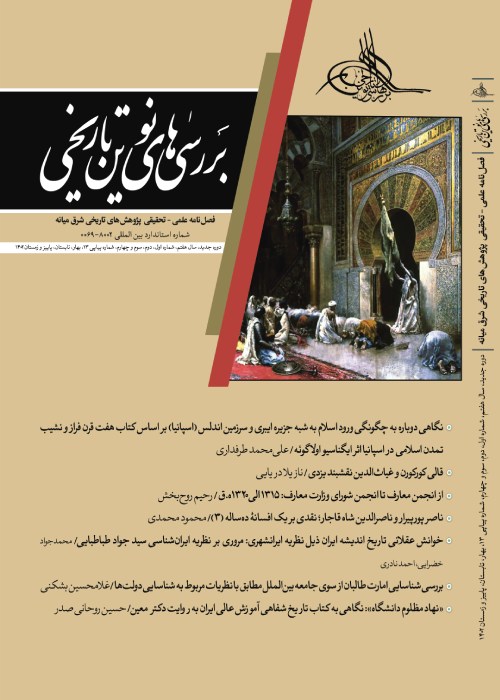Similarities in the composition of Akhlāq-e Nāsiri, Misbāh al-Hidāya wa Miftāh al-Kifāya
Author(s):
Abstract:
Khwaja Nasir al-Din Tusi (AH 597-672) is a well-known Persian figure from the Iranian city of Tous, who made invaluable contributions to natural sciences, philosophy, mathematics, literature, fiqh (Islamic jurisprudence) and politics of the Ilkhanid period. He founded Maragha’s observatory. His Akhlq-e Nsiri (AH 633) is usually considered to be a translation of Tahdhib al-Akhlq wa Tat’hir al-Arq (Taharat al-Arq) by Ibn Miskawayh Rzi as Misbh al-Hidyah wa Mifth al-Kifya by Mahmood Kshni, another scholar of the Ilkhanid era, is regarded as a translation of Awrif al-Marif authored by Sheikh Shahbeddin Sohrevardi. The most important point is that although Tahdhib is the base and the main source of Akhlq e-Nsiri, it cannot be properly considered as the translation of Ibn Miskawayh’s Taharat al-Arq. Rather, Tusi chose not to be faithful to Ibn Miskawayh’s text, extracting the fundamental meaning of the text and writing in a way which would fit Persian culture and the Persians’ previous knowledge. To do so, he explained, elaborated on, added and dropped some parts of the original text. Also, the points made by the late Jalaledin Homi in his introduction to Misbh al-Hidya wa Mifth al-Hidya concerning the possibility that Mahmood Kshni may have been inspired by the statements made by Tusi in the preface of his book as well as in its composition and style, and that while translating Awrif al-Marif Mahmood Kshni had adopted the approach used by Tusi in translation of Taharat al-Arq encouraged me to analyze both books more closely. This paper sets to examine the similarities between Akhlq-e Nsiri and Misbh al-Hidyah wa Mifth al-Kifya in terms of translation and composition using content analysis method. Attempts have been made to demonstrate the adaptation of a similar approach in translation, creation of the Farsi versions ofthe both texts from the Arabic source through translation in a fairly similar way, and finally the inspiration of Izz al-Din Mahmoud Kshni from Tusi in his style of translation and writing through showing parts of the features shared by Akhlq-e Nsiri when compared to Tahdhib al-Akhlq and Misbh al-Hidyah wa Mifth al- Kifya when compared to Awrif al-Marif.
Keywords:
Language:
Persian
Published:
New Historical Studies, Volume:1 Issue: 2, 2015
Pages:
35 to 51
magiran.com/p1389333
دانلود و مطالعه متن این مقاله با یکی از روشهای زیر امکان پذیر است:
اشتراک شخصی
با عضویت و پرداخت آنلاین حق اشتراک یکساله به مبلغ 1,390,000ريال میتوانید 70 عنوان مطلب دانلود کنید!
اشتراک سازمانی
به کتابخانه دانشگاه یا محل کار خود پیشنهاد کنید تا اشتراک سازمانی این پایگاه را برای دسترسی نامحدود همه کاربران به متن مطالب تهیه نمایند!
توجه!
- حق عضویت دریافتی صرف حمایت از نشریات عضو و نگهداری، تکمیل و توسعه مگیران میشود.
- پرداخت حق اشتراک و دانلود مقالات اجازه بازنشر آن در سایر رسانههای چاپی و دیجیتال را به کاربر نمیدهد.
In order to view content subscription is required
Personal subscription
Subscribe magiran.com for 70 € euros via PayPal and download 70 articles during a year.
Organization subscription
Please contact us to subscribe your university or library for unlimited access!



